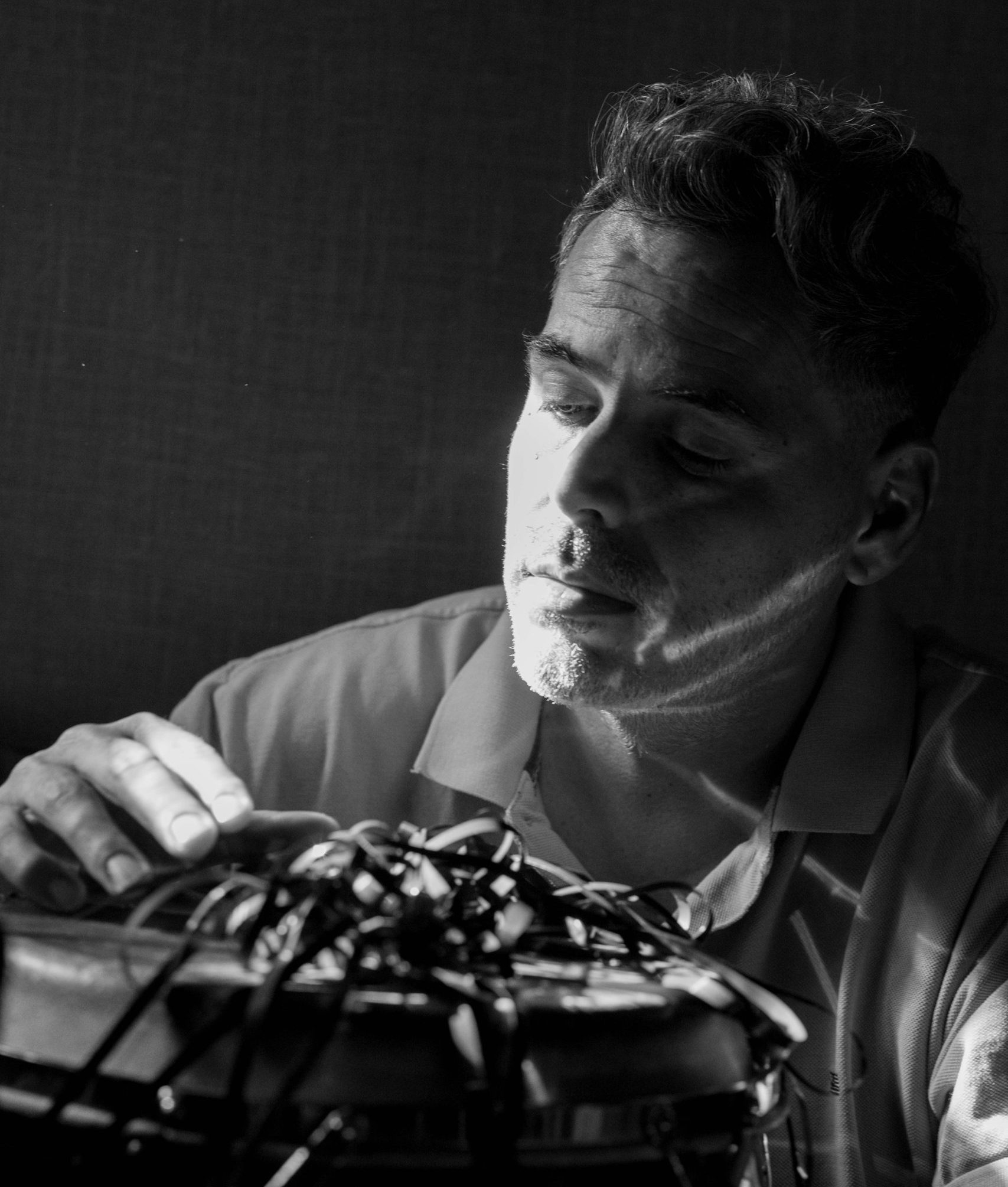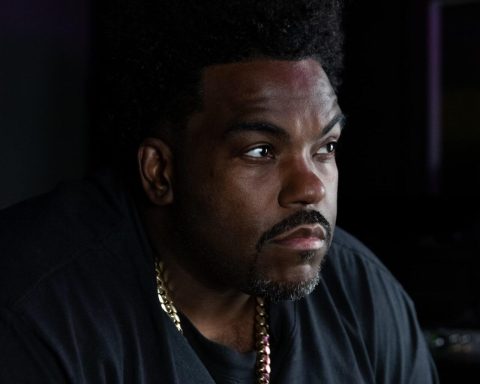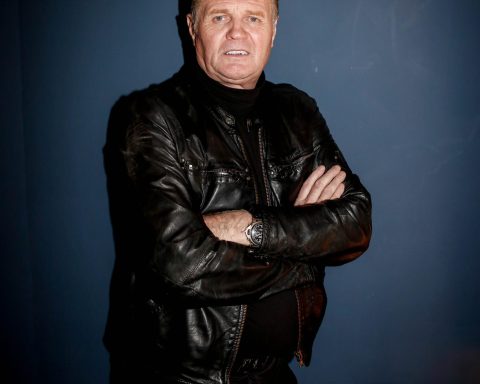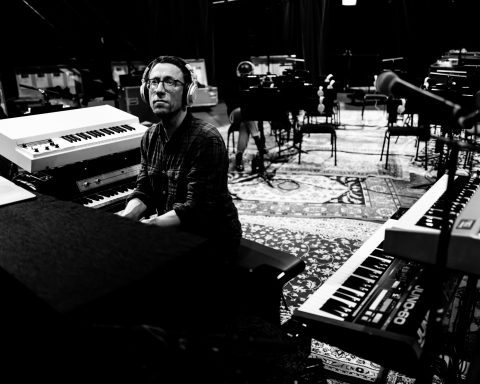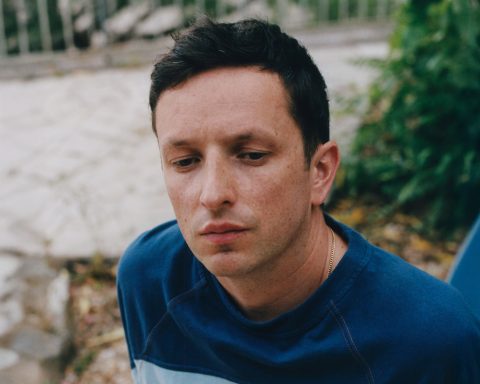In the age of AI, Mocky poses a pair of timeless questions: Why do we create, and who are we creating for? On his Stones Throw debut, the LA-based producer took a one-mic, one-take approach, gathering friends and acquaintances in his garage to capture a unified voice in a divided, digital world. Music Will Explain (Choir Music Vol. 1) is more than just an album; it’s a human response to the artificial. Rooted in soul, jazz, and childhood memories of Sesame Street, Mocky weaves choral vocals around raw harmonies and live instrumentation to fashion a sound only humans could create.
Immersed in Futurism
You’ve always been a proficient musician, yet your early music was very sample-based. Was that primarily because it was an affordable way to begin?
The short answer is yes, but there were a few other factors. I played in bands, studied jazz, and was pretty much a certified multi-instrumentalist by the time I left Canada. But everyone played guitar back then, and I was more inspired by Squarepusher, Aphex Twin, and hip-hop bands like Wu-Tang Clan. I didn’t see myself strapping on a guitar, and when I moved to London, I was squatting on Brick Lane, playing bass for Talvin Singh, and working in pirate radio. I was always into futurism, so when I ended up in Berlin a couple of years later, I became fully immersed in what I called the pre-DM scene.
How did things evolve from that point?
I was making electronic music on my laptop and produced a record called Multiply with Jamie Liddell. He’s got a brilliant voice and was standing right between the crossroads of electronic music and a more soulful sound, so I found myself playing instruments and writing songs with him. One half of that record was blue-eyed soul, and the other half was looped electronic, experimental stuff. From that point, I started to connect the dots and ended up producing Feist, which wasn’t electronic at all.
Being Human
Did these collaborations help you to mould your sound?
The big opportunity came when one of the biggest shopping malls in Austria ripped off one of my early electro-rap songs. I won a lawsuit and out of nowhere went from sleeping on couches to having more money than I’d ever had before. At the same time, a good friend, Chilly Gonzalez, told me that my electronic stuff was good, but maybe I should think about making jazz compositions like I had before I left Canada. At that point, something clicked, and I decided to capture the sound of a human in a room in a modern and impressionistic way.
So I took the money and blew it all on 10 days at Studio Ferber in Paris, where Nina Simone and Ray Charles once recorded, rented out all of my favourite gear, and composed and produced a song every day. That was the Saskamodie album, where I purveyed acoustic stuff in a relevant and electronic way. As technology keeps advancing, I’m still trying to discover how to hold up the human side of the bargain, and that seems more significant than ever right now.
"Something clicked, and I decided to capture the sound of a human in a room in a modern and impressionistic way."
What role did synth hardware play in bridging the man and machine divide?
When I lived in Toronto, I had a Roland SH-1000, which, in 1973, was the first compact synth ever made in Japan. It was in the same category as a Moog in terms of how you could control sounds, and for whatever reason, that keyboard just does it for me. It always fills the gap when I need to make a spacey, high-end synth sound that’s also really chunky. In the early 1970s, they really made things to last, and I’ve been using it ever since.
"As technology keeps advancing, I'm still trying to discover how to hold up the human side of
the bargain."
Ghostbusting Ideas
You’ve moved into soundtrack work in recent years. Some artists stay there, but you’ve continued making studio albums.
I was touring Japan when a famous anime director, Shinichirō Watanabe, came to my show with another legend, Cornelius. The plot was set in the future when AI is taking over music, and they wanted an acoustic, human element for their new anime, Carole & Tuesday. That’s where my double nature of making acoustic and electronic music came into effect.
But I’m also someone who hears a sound in my mind and starts chasing it. If you can honor that or kind of ghostbust it, those sounds can be a germane seed for songs that are so simple and self-evident. Accepting those gifts is a big part of what I do to get outside myself, and then the job is to find out how to make them sound relevant.
This all feeds into your new LP, Music Will Explain (Choir Music Vol. 1). How does the material relate to choral music and the sound of the human voice?
I’d finished an album that I was pretty happy with, but one of my close collaborators said that although every song was good, they didn’t think it made a strong enough statement. At the same time, there’s been this massive advancement in AI that you can’t escape, and the album almost felt like what AI would have made if you’d asked it to create Mocky’s next funky, organic jam. That was quite a heartbreaking realization for me, but I saw the truth in it and decided to start again from scratch.
Around the same time, another friend reminded me that I was working on choir music before I came to LA, and that’s when I found the missing thread. From that moment, I realized that I needed to put humanity right up front because, alongside the drum, the human voice is always the first sound you hear in the room.
"Alongside the drum, the human voice is always the first sound you hear in the room."
I bought an old Ampex tape machine from a TV station in Santa Monica for almost nothing, finally got it working, and found an incredible-sounding ’50s Neumann mic from an old church in Berlin. I pretty much set that single mic up and brought over some of the most incredible singers, friends, and musicians to gather around it, recording straight to tape. From the piano, I’d give them melodies or play these complicated chords with upper extensions, relying on every idea I had about making crazy vocal chords like Manhattan Transfer or Gil Evans.
It was difficult to make it sound right, but at a certain moment, the voices all turned into one, and I couldn’t tell who was singing anymore. We’d suddenly reach this thing that’s always been so mysterious to me, a sort of Brazilian, disco-style Bee Gees/Beach Boys sound where you have group vocals carrying a song, but you’re not questioning who is singing. From that moment, everything became unified.
Capturing Vocals
Had you actually written any songs by that point?
I had some sketches, but felt the most important thing would be to build the songs around whatever I could capture from the vocalists. The modern version would have been for everyone to have headphones on with some sort of playback, but I was after the sound of people in a room making music.
On computers, the high end is never very satisfying and becomes brittle, but with tape machines, you can keep cranking it up until even the hiss sounds good. After recording all my instrumentations and vocals to tape, I put everything in the computer, arranged it, and became the electronic musician. Still, those limitations allowed me to push the story behind the album.
The track “Just A Little Loving,” in particular, has a familiar theme.
It’s the first cover song I’ve ever done. The original was by Dusty Springfield, but you’re not going to improve upon that, right? When I look at doing covers, I’m always looking to do something different, and while most singers would want to make it their own, in this case, it was choral, so that was already different. I also want to make music using heritage sounds without sounding stuck in the vintage bin.
To my ear, ’70s synth music is the peak of old-world technology meets the ’80s, and I like to wonder what if things had taken a different route, or I could plot an alternate course. You can’t beat the old stuff or make better soulful songs than Motown, but you can hopefully find something within that and make it sound modern and relevant.
"You can't beat the old stuff or make better soulful songs than Motown, but you can hopefully find something within that and make it sound modern and relevant."
Evolutionary Struggle
You touched on AI, a hot topic in the music industry, yet you’re not sold on it now?
I’m sort of two-fold. As a futurist, I’m all for using AI to make something amazing, but until now, I don’t believe AI is making anything amazing. This record was made without AI, and I even thought about putting a sticker on it because using AI is kind of like firing yourself. The idea is not to get replaced by AI, but to be smart enough to incorporate it in a way where it’s not going to take over your job.
I truly think we’re in an evolutionary struggle between technology and humans, and a lot of people would say technology will win. Still, it’s important to have a story, so why would I care about something that doesn’t have a reason to do the things it does?
"The idea is not to get replaced by AI, but to be smart enough to incorporate it in a way where it's not going to take over your job."
Are you optimistic that, in the long run, things will come full circle, like vinyl has?
It’s a cliché, but I don’t think you can replace that feeling of seeing people enjoying playing music together. My crew writes and plays together constantly, but there’s no such thing as a wrong note because it’s up to the other person to adapt and change what they’re doing. That musical trust gives musicians the freedom to play, which is hard to replace, and who would want to see two computers doing that anyway? I’m not sure if I’m optimistic, but I’m ready for the challenge of figuring out what my next album is going to be, and it has to be something that AI can’t do.
Computers Can’t Add
Are vintage synths just as irreplaceable as the human voice?
I’ve made entire albums on laptops with VSTs and totally get it, but I like those fat, heavy keyboards that weigh something. From my experience, you plug them in, and they add something to your track because they contain their own energy. I’m not an engineer, so I can’t talk to you about algorithms, but outboard gear was made from the mind state of making something that lasts, whereas computer gear is made to be updated.
Computers, by their very nature, can faithfully reproduce a sound, but they can’t add anything in the same way that moving the knob on an old synth creates a little crackle or one-time noise. When I work with collaborators or younger musicians, I often say, “Okay, even if you’re doing the whole thing on your laptop using loops, try to add one element from a hardware synth.” Because now you have a little bit of copyright on that moment in time. I used the JUNO-6 on this record because it has this great, airy organ sound that only JUNOs can do.
"I used the JUNO-6 on this record because it has this great, airy organ sound that only JUNOs
can do."
You parenthesized the LP Choir Music Vol. 1. Presumably, can we expect a second part of the project?
I’m in research and development mode right now, making all kinds of music and collaborating with a lot of Stones Throw artists. I’m open to the universe, so my next record might be Choir Music Vol. 2, or I might make a mix tape. Part of being human is about allowing a little of life to go by and then reacting to the next step. Otherwise, I might as well tell AI to go ahead and make volume two for me right now.
